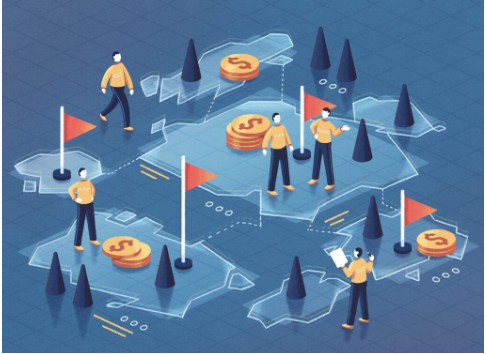RWA (Real World Assets) is undoubtedly one of the hottest concepts in the crypto industry today.
Maker, as a pioneer representative, has eaten the dividend of the high-interest rate cycle by opening up the profit window for US bonds, thereby amplifying the market demand for DAI, and ultimately pushing up its own market value in the downturn. Subsequently, projects such as Canto and Frax Finance have also achieved certain success through similar strategies. The former has doubled its coin price within a month, and the latter has just launched sFRAX with the V3 version, with an impressive scale growth rate.
So, is the RWA concept really so "simple and easy" that it can always improve project fundamentals quickly and steadily? Two recent lessons in the market suggest that the situation may not be so simple.
Goldfinch Bad Debt Incident
One of them is the bad debt incident of Goldfinch.
Goldfinch is positioned as a decentralized lending protocol. In 2021, Goldfinch has completed three rounds of financing totaling up to $37 million (1 million USD, 11 million USD, 25 million USD), with the latter two rounds led by a16z.
Unlike traditional lending protocols such as Aave and Compound, Goldfinch primarily serves the real-world commercial credit needs. Its general operating model can be divided into three layers.

As a lender, the 'user' can inject funds (usually USDC) into different themed liquidity pools managed by different 'borrowers', and earn interest income (profits come from real business profits, generally higher than the regular DeFi level).
The 'borrower' is generally a professional financial institution from around the world, which can allocate the funds in the liquidity pool it manages to real-world 'enterprises' with existing needs based on its own business experience.
"Enterprises" will invest in developing their own business after obtaining funds, and regularly use a portion of the profits to repay "users" for loan interest.
Throughout the entire process, Goldfinch will review the "borrower's" qualifications and regulate all details of the loan terms to "ensure" (which now seems somewhat ironic) the safety of the funds.
However, unexpected events still occurred. On October 7th, Goldfinch disclosed through the governance forum that an unexpected situation occurred in the liquidity pool managed by the "borrower" Stratos. The total size of the pool is 20 million US dollars, and the expected loss is as high as 7 million US dollars.
Stratos is a financial institution with over ten years of experience in credit business. It is also one of the investors of Goldfinch. From its qualifications, it seems quite reliable, but obviously Goldfinch still underestimated the risks involved.
According to the disclosure, Stratos allocated $5 million of the $20 million to a US real estate leasing company called REZI, and another $2 million to a company named POKT (whose business is unclear, Goldfinch claims to not know what the money was used for...), both of which have stopped paying interest. Therefore, Goldfinch has written off these two deposits as 0.
In fact, this is not the first time that Goldfinch has encountered bad debt problems. In August of this year, Goldfinch disclosed that the $5 million loaned to African motorcycle rental company Tugenden may not be able to recover the principal, because Tugenden concealed the flow of funds between its internal subsidiaries and blindly expanded its business, resulting in huge losses.
The recurring bad debt issues have seriously undermined the confidence of the Goldfinch community. Many community members have raised questions about the transparency and review capabilities of the protocol in the comments section below the disclosure page regarding the Stratos incident.
USDR Anchor Drifting Incident
On October 11th, the stablecoin USDR, supported by real estate (ummm, this is a double kill...), began to seriously deviate from its peg and is currently trading at a discount of 0.515 USD. Based on its circulation of 45 million, the total loss for holders is close to 22 million USD.

USDR is developed by Tangible on the Polygon network and can be minted by staking DAI and Tangible's native token TNGBL. The minting ratio for staking DAI is 1:1, while the staking limit for TNGBL is restricted to no more than 10% due to risk considerations.
The reason for emphasizing "tangible real estate support" is because Tangible will use the majority of the collateral assets (50% - 80%) to invest in tangible real estate in the UK (after purchase, corresponding ERC-721 certificates will be minted), and provide additional income to USDR holders through property leasing, thereby increasing the market demand for USDR and connecting the vast real estate market to the crypto world.
Considering the potential redemption needs of users, Tangible will also reserve a certain amount of DAI and TNGBL in the collateral assets. The reserve scale for DAI is 10% - 50%, while the reserve scale for TNGBL is 10%.
However, Tangible clearly underestimated the scale of redemption demand under the squeeze situation. In the early morning of October 11th, the USDR treasury still reserved 11.87 million DAI, but within 24 hours, users redeemed tens of millions of USDR and exchanged them for assets with higher liquidity such as DAI and TNGBL for sale, which also caused the TNGBL price to plummet, indirectly leading to the shrinkage of the collateral assets and further exacerbating the anchoring situation.
Afterwards, Tangible has announced a three-step disposal plan:
One is to emphasize that USDR still has an 84% mortgage rate;
Secondly, tokenize the real estate assets it owns (if there is no demand, it will consider liquidating the properties directly);




All Comments